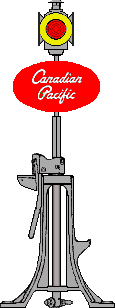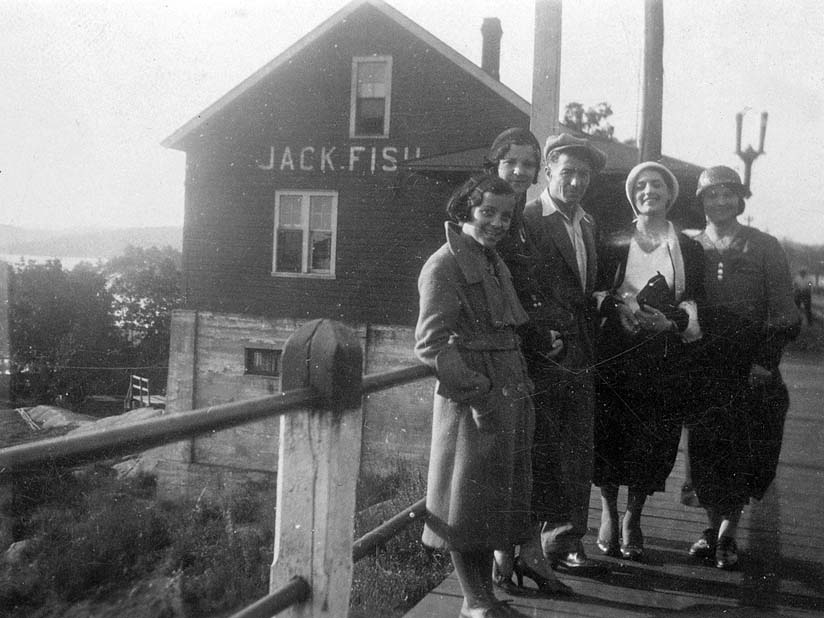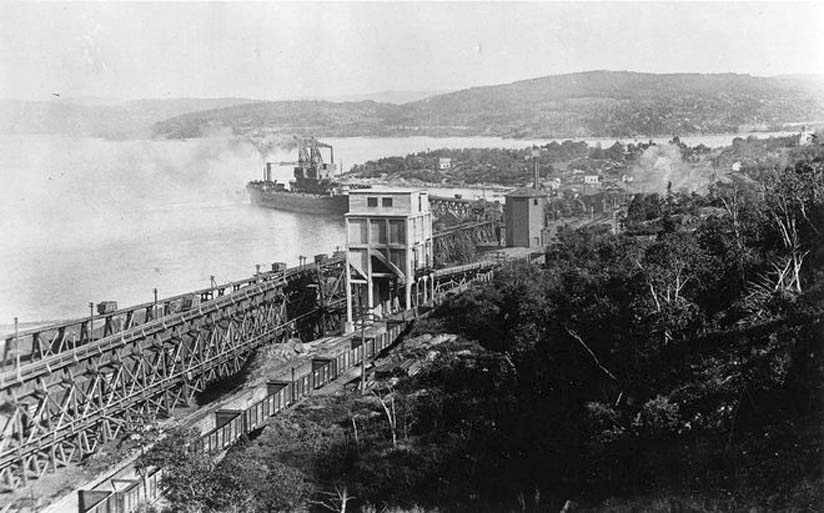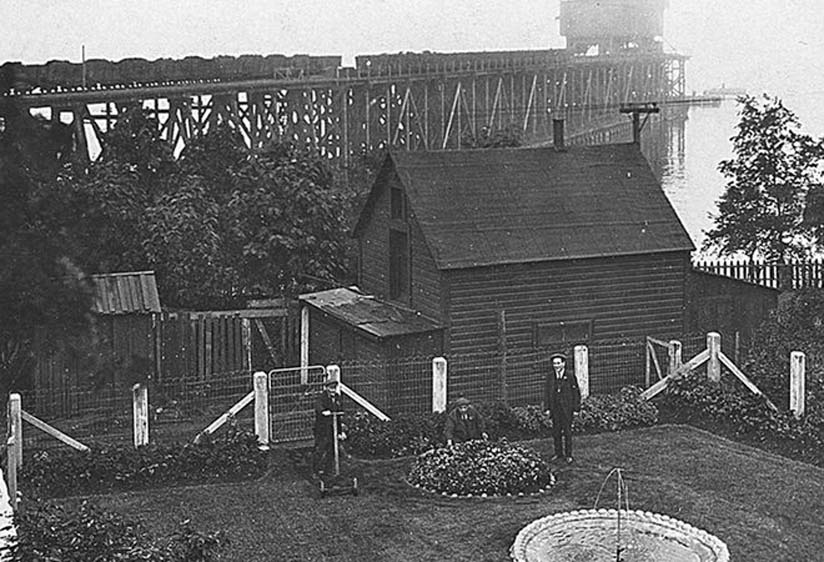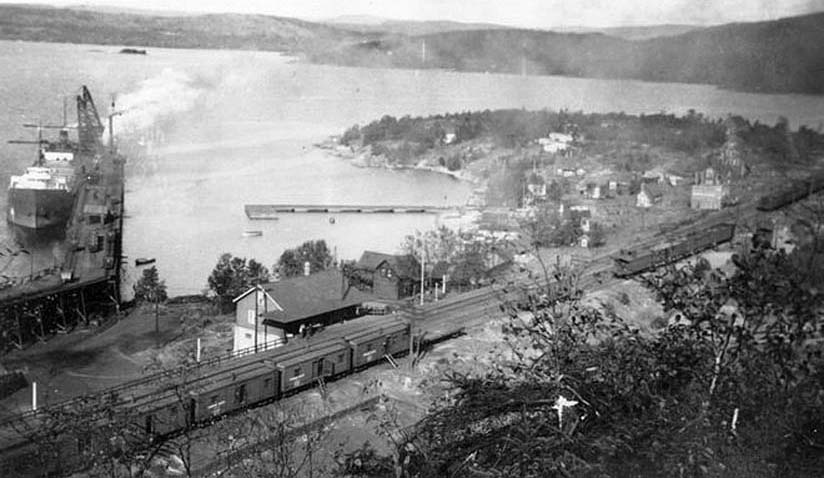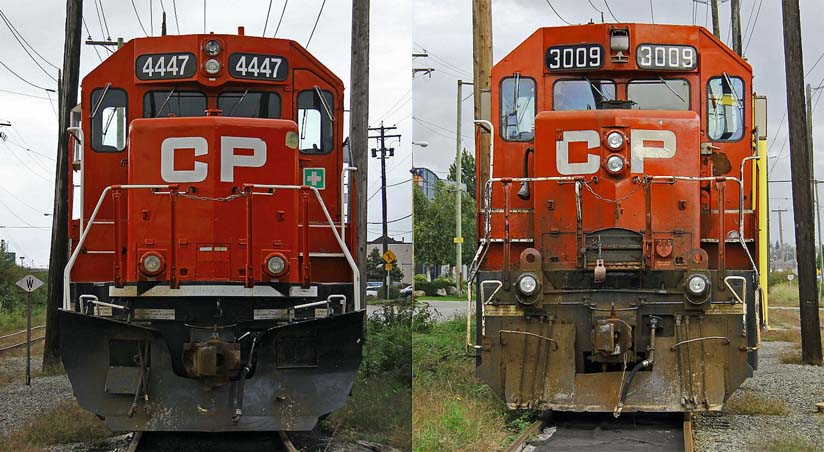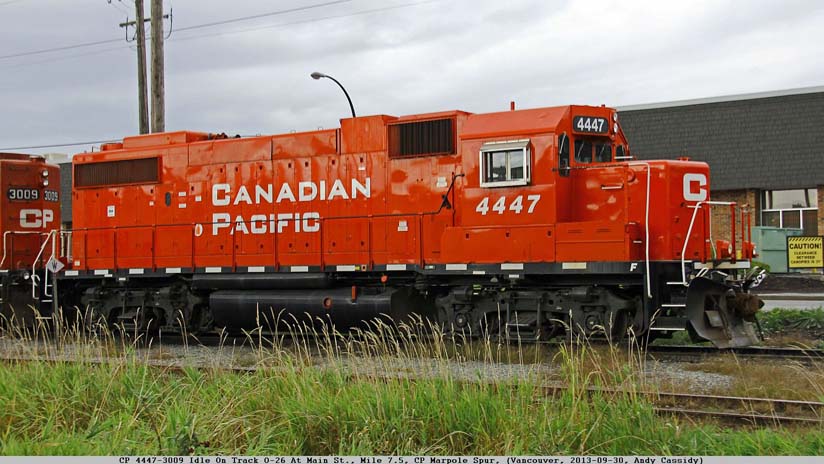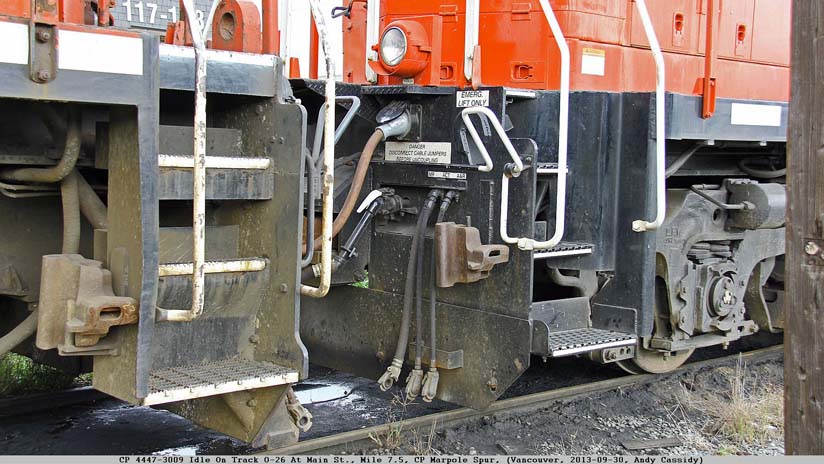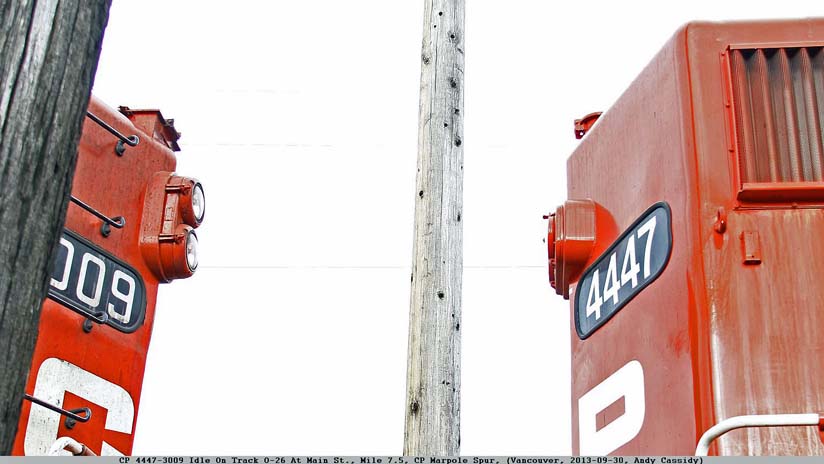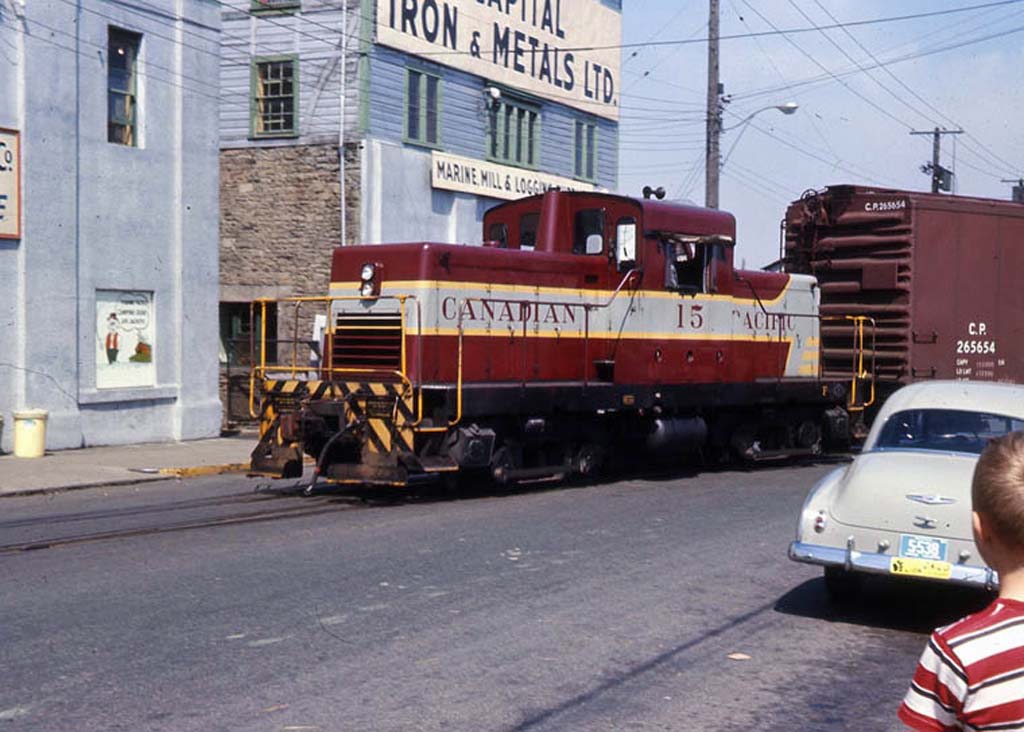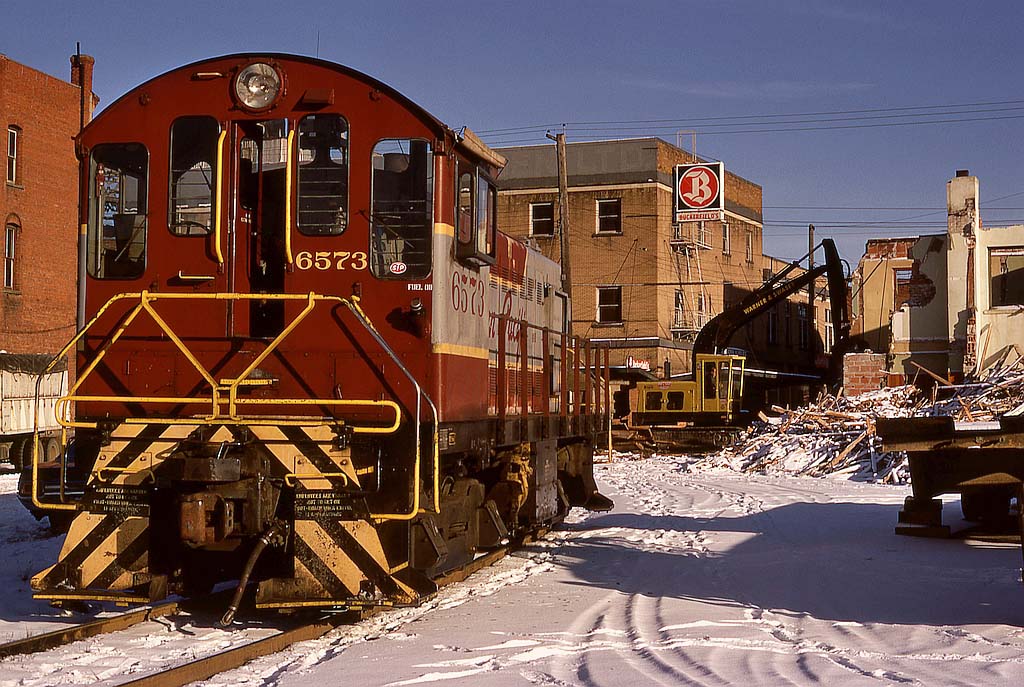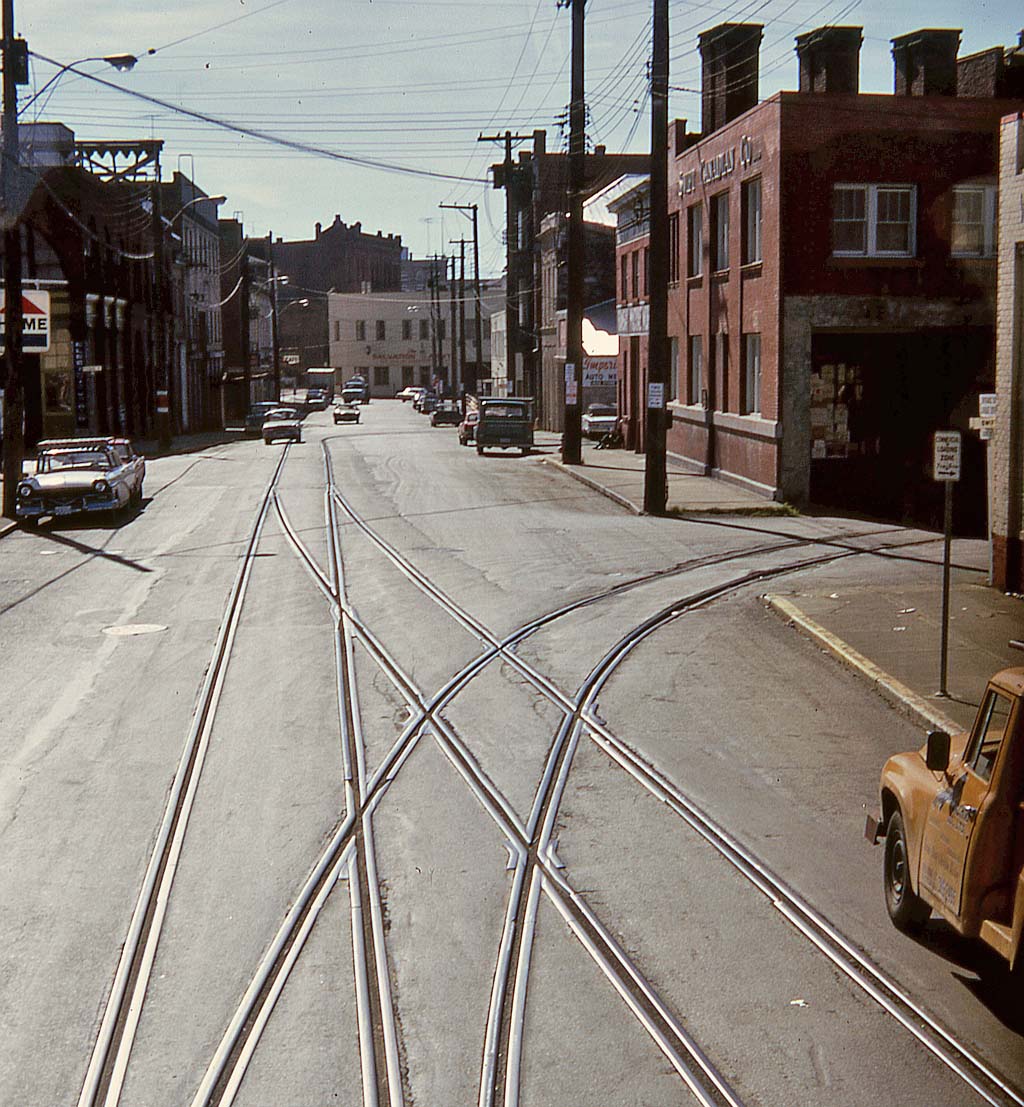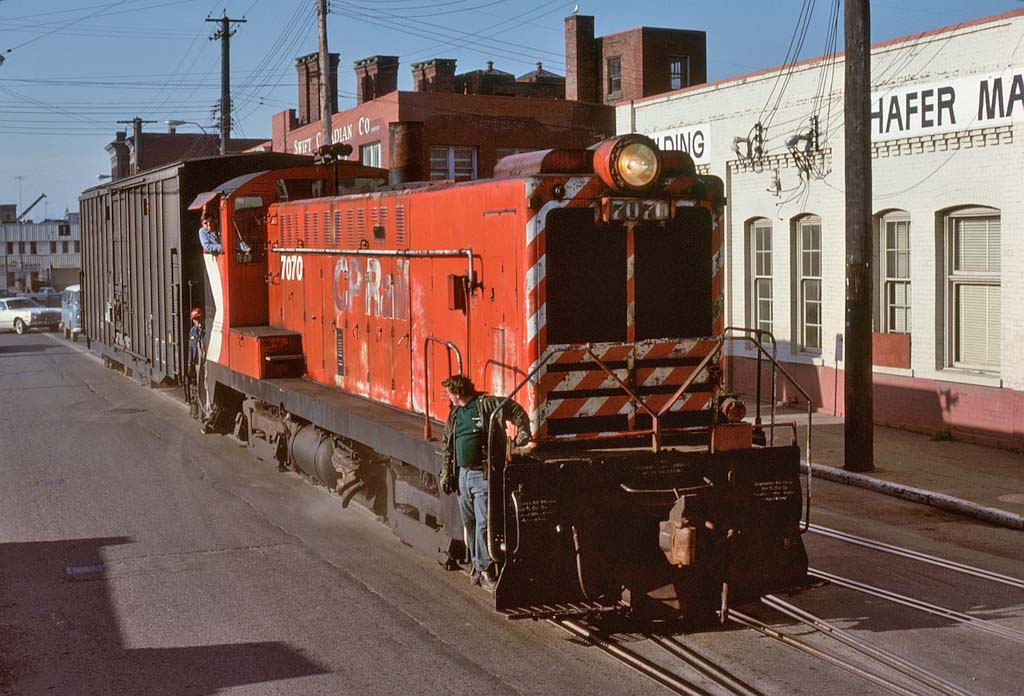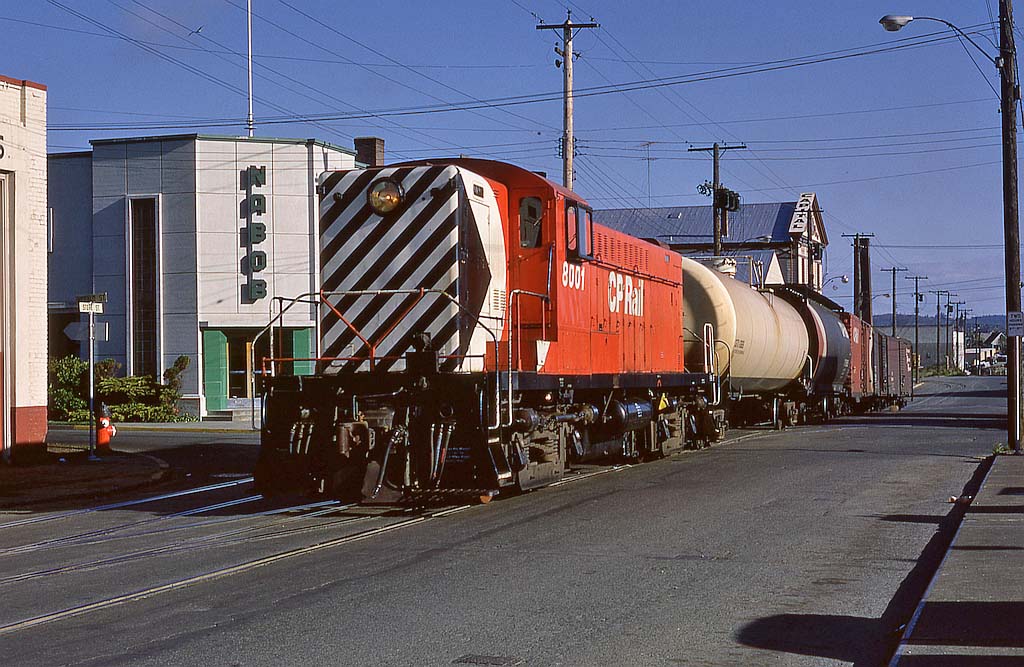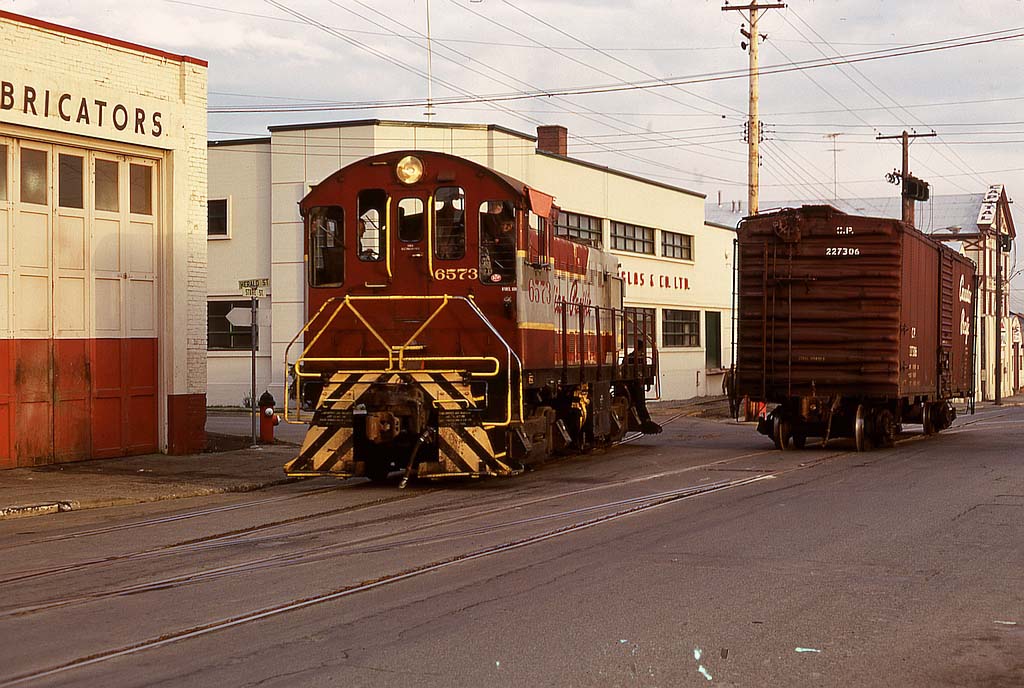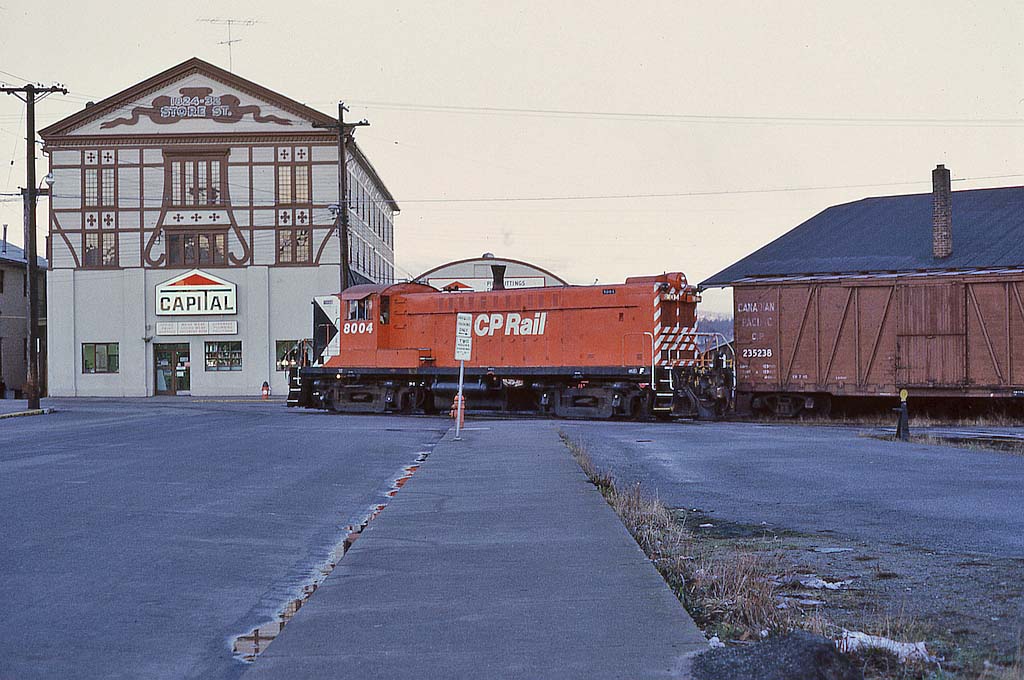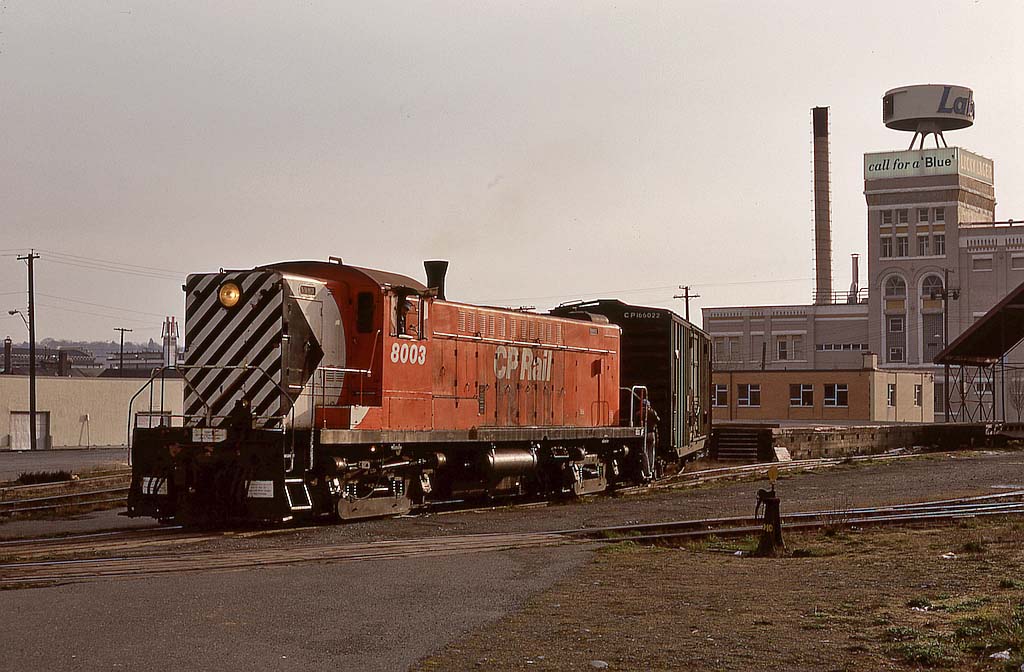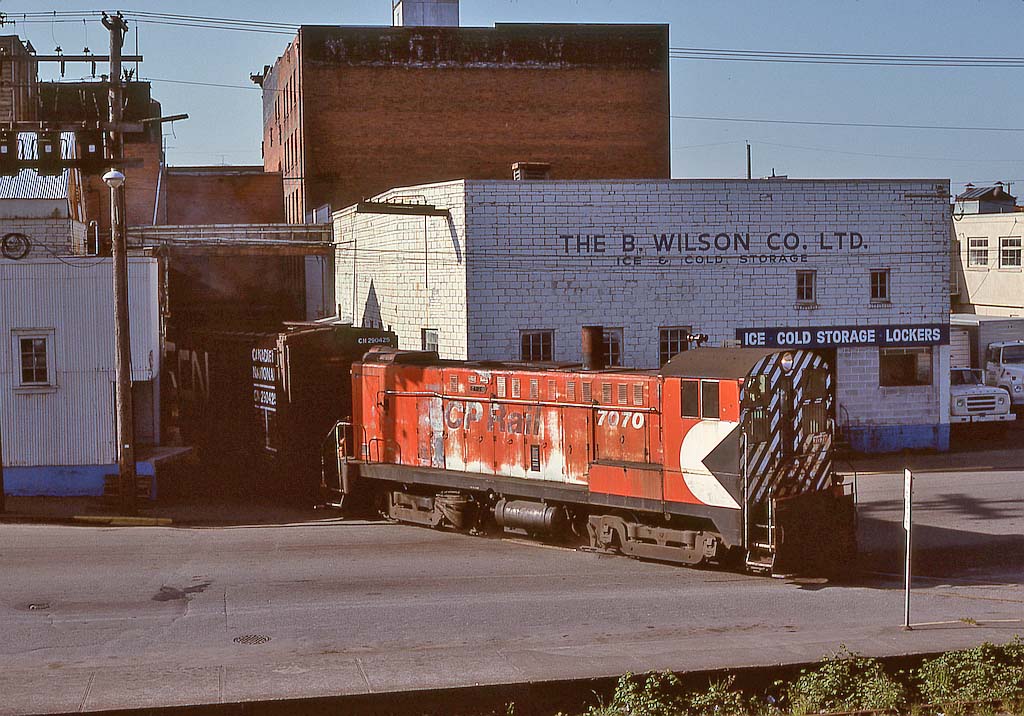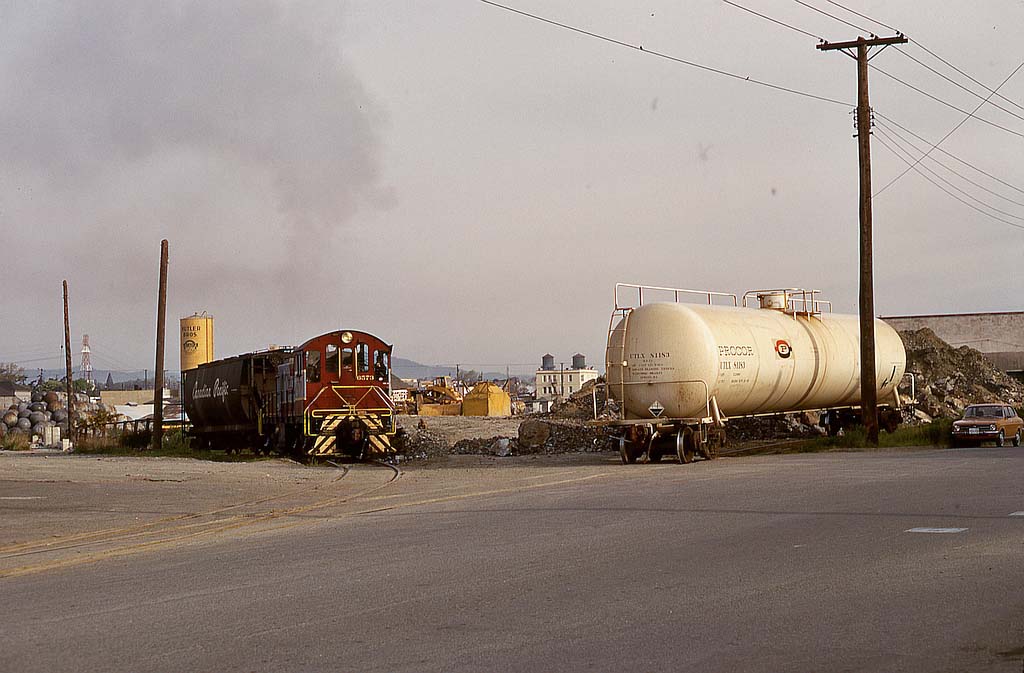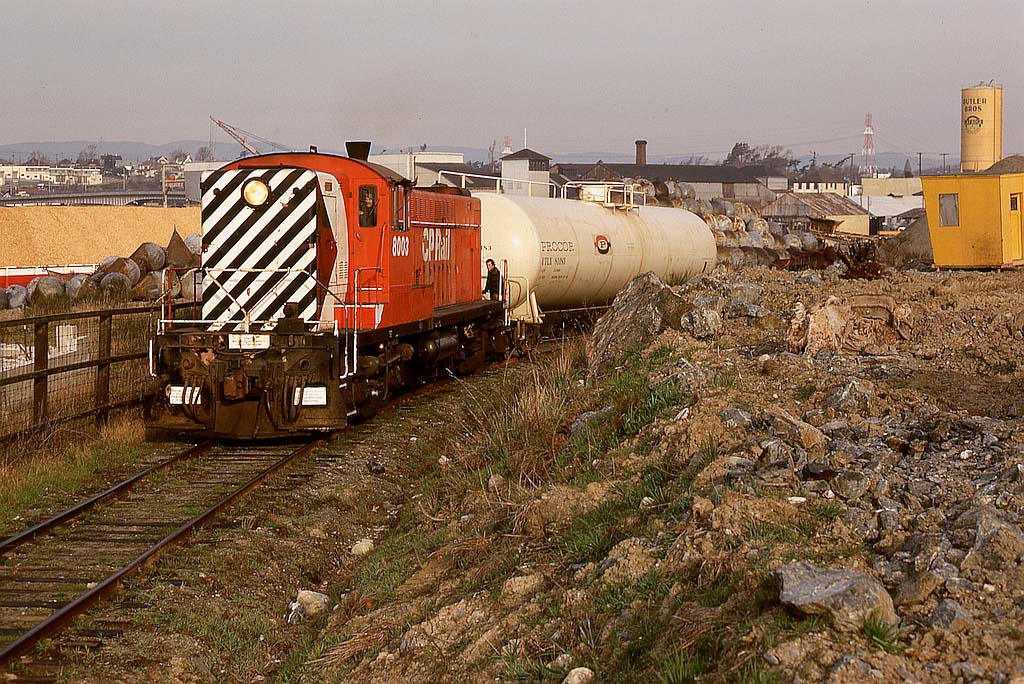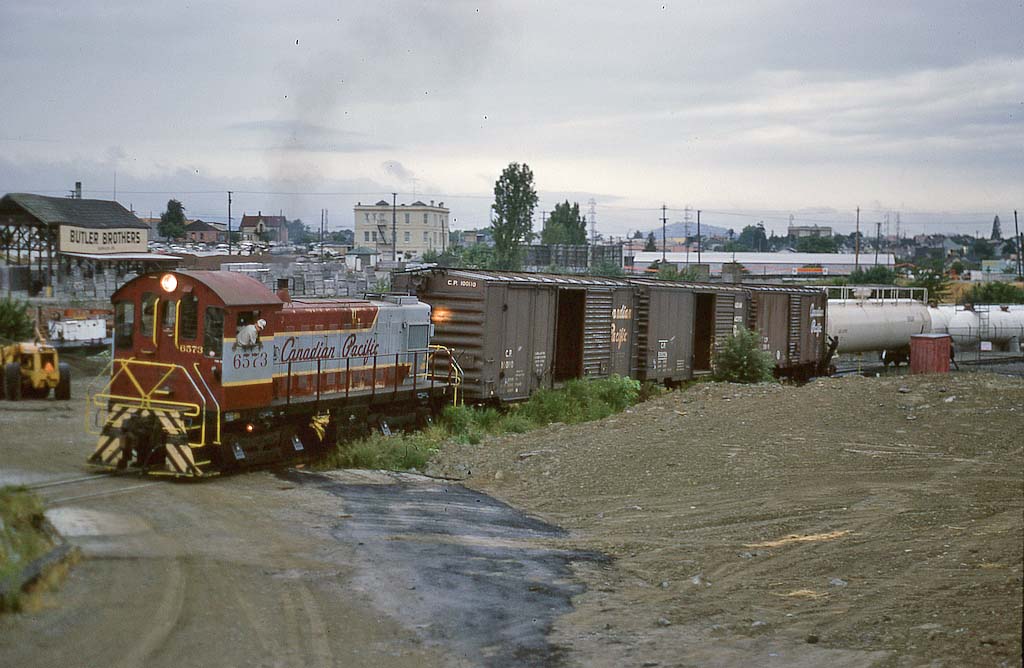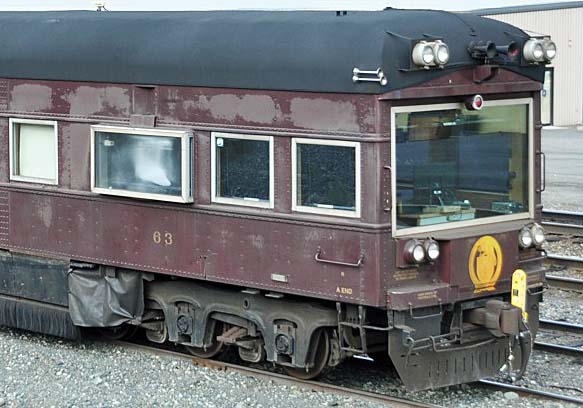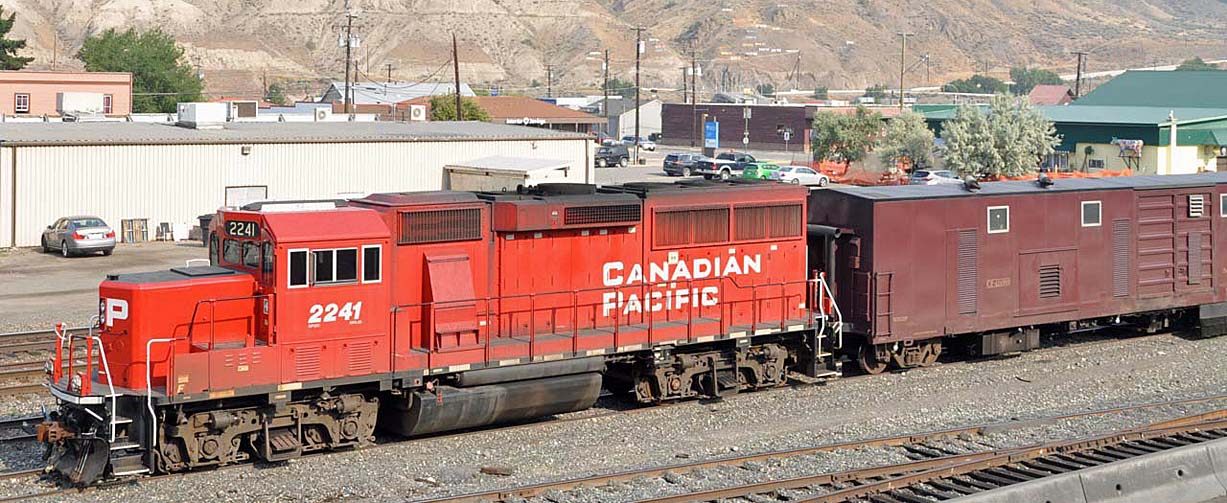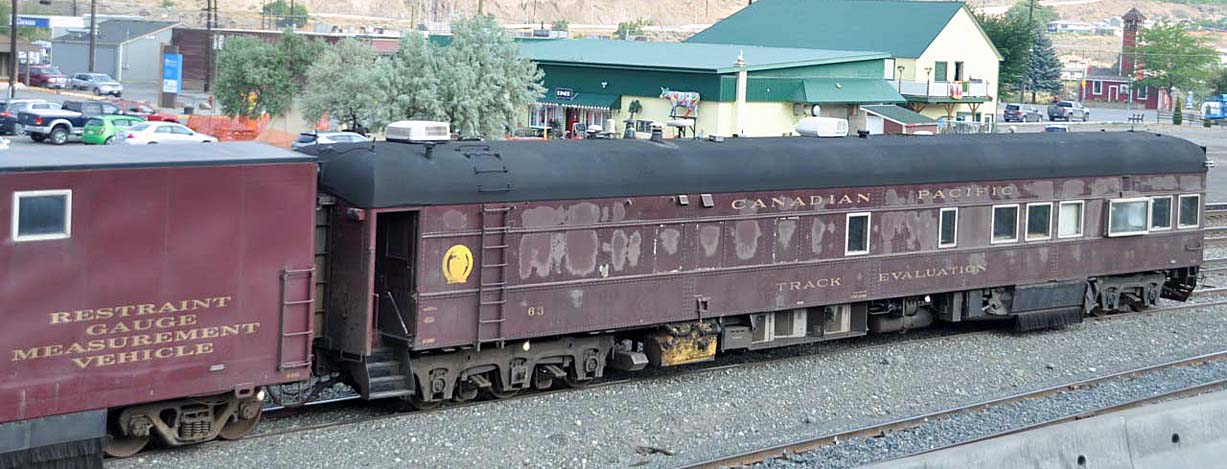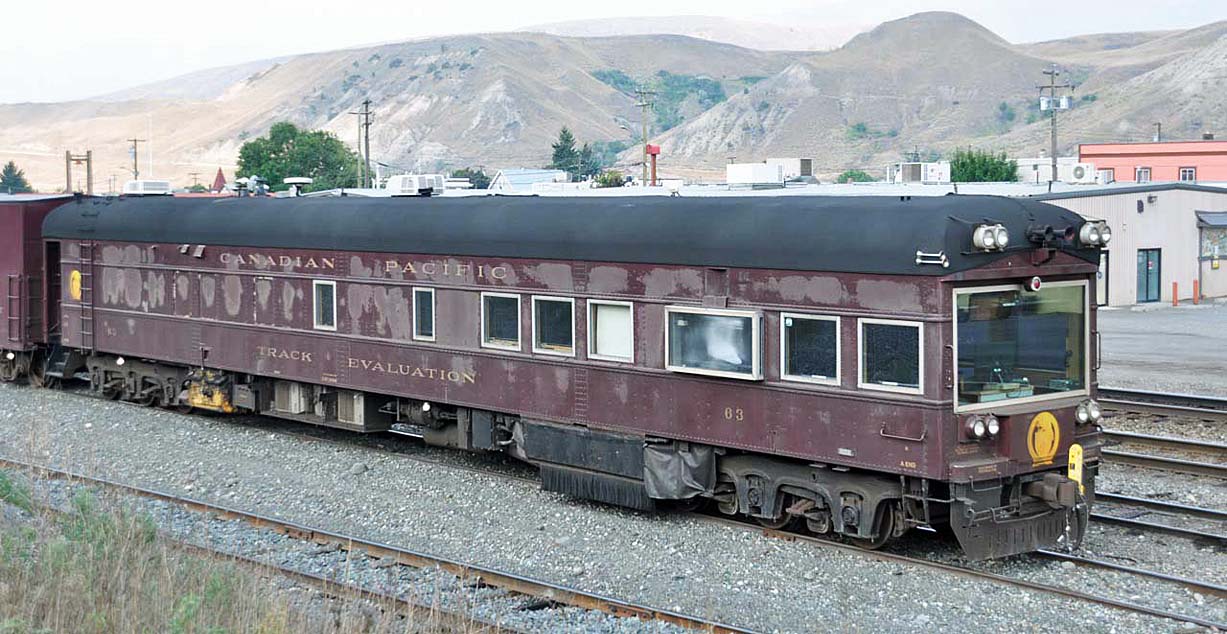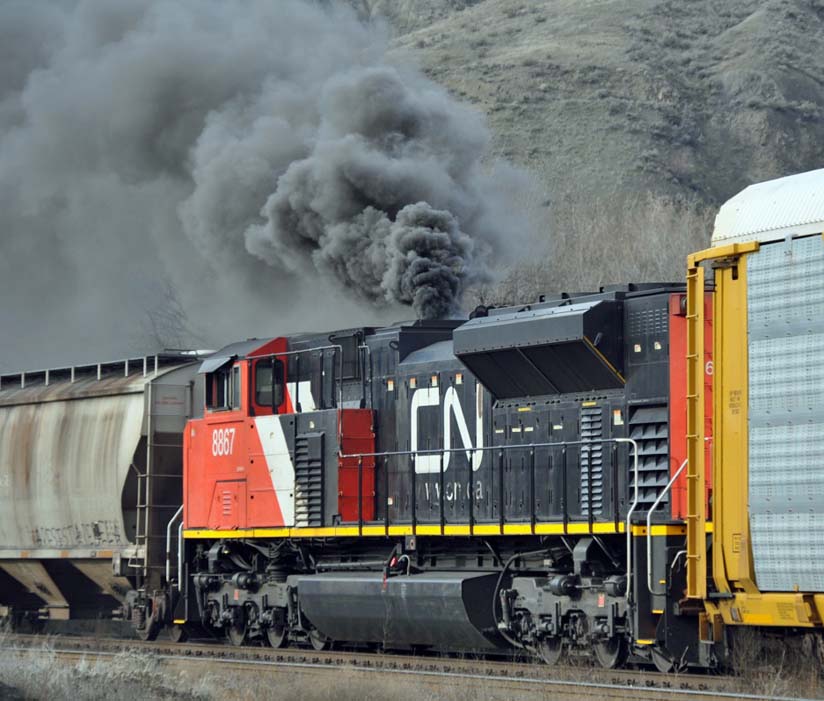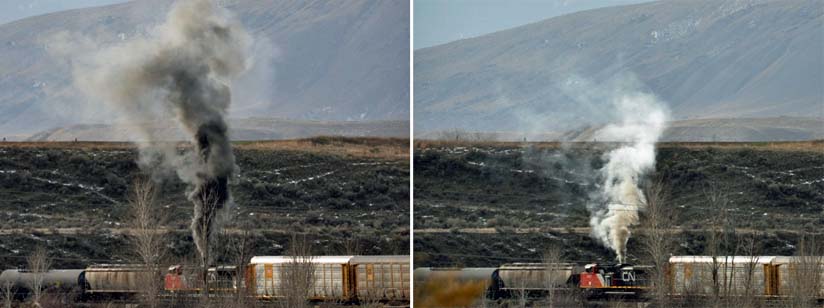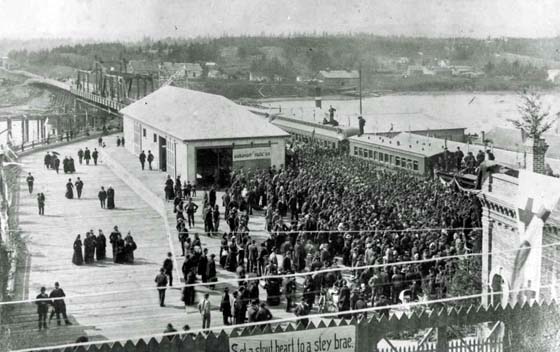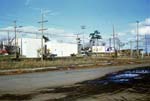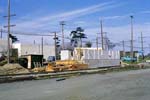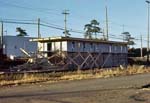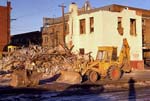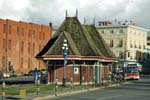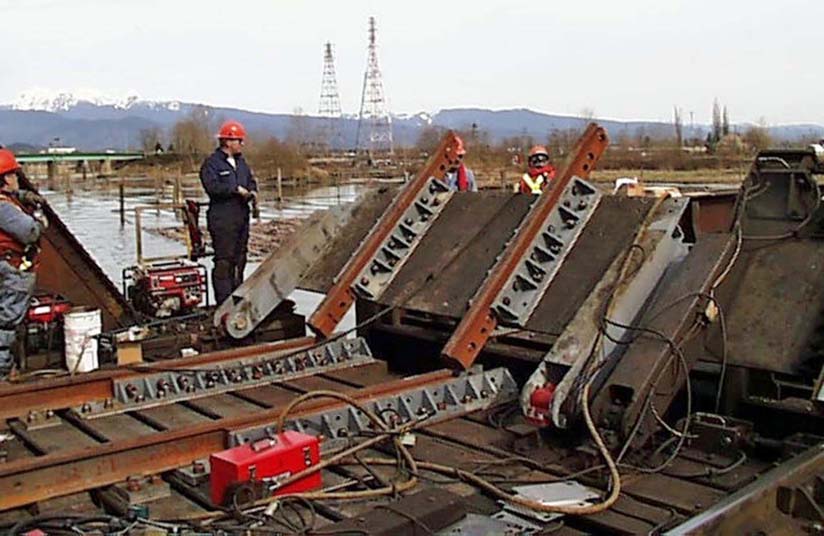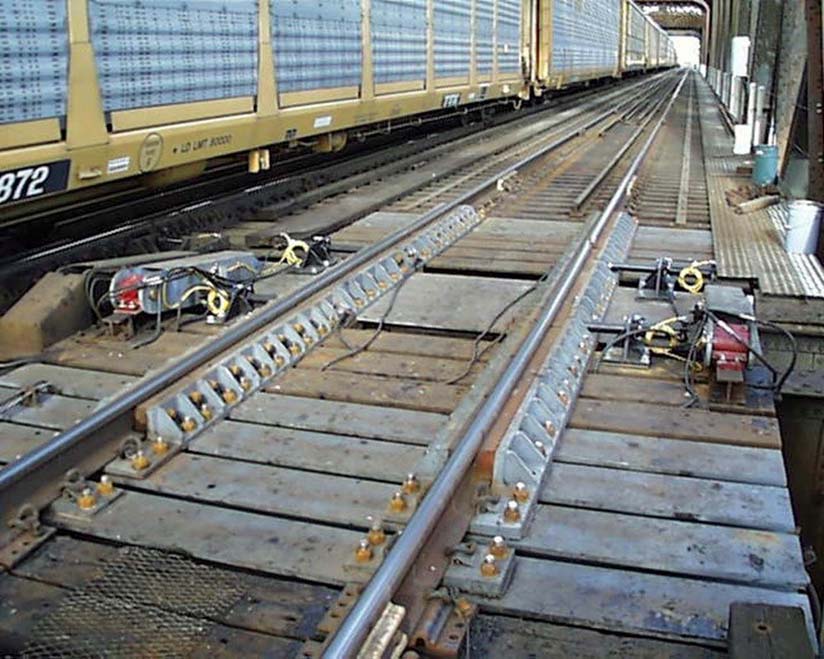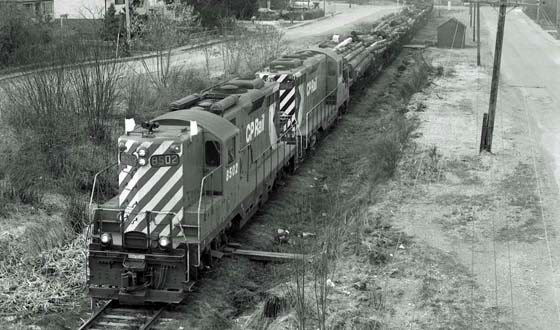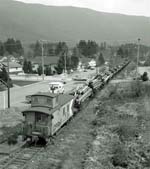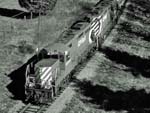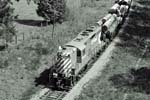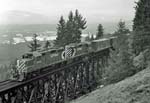 Table of Contents
Memories of a Lake Superior Ghost Town - Lyle Nicol
EMD Vs. GMD - Andy Cassidy
Store Street - Ken Perry
Gauge Restraint Measurement Vehicle - Doug Phillips
Holy Smoke! - Andy Cassidy
E&N Victoria Stations - Ken Perry
Winter Rail - Roy Matthias
The Last Log Train - Ken Perry
 Introduction OKthePK's website "Last Call" page has appeared weekly over the past few years. Each week a different article told the story of various railway items of interest. While some of the articles were saved they are no longer available online. Many of those about the Canadian Pacific Railway have been compiled here on this page. There is insufficient room to display more than a few Last Call articles per page. As a result, "Canadian Pacific Odds and Ends - Part 15", continues this month with more possible parts to follow as time passes.  Memories of a Lake Superior Ghost Town Memories of a Lake Superior Ghost Town Lyle NicolA group posed by the railroad station - Circa 1930 Photographer? 1 February 2022
Jackfish Ontario - Jackfish is a real ghost town.
When I visit, I imagine the wind whistling through the bulkheads of the old coal freighters that once plied Lake Superior to get there.
Now the wind buffets through the rock cuts that guard both ends of the abandoned village on the mainline of the Canadian Pacific Railway (CP).
The spirit of the past is present in the reality of today.
I always feel it.
And I hear it.
I have "Jackfish ears" that let me differentiate between the sounds of the waves, the wind, and the trains.
"There's a train coming," I tell visitors as we walk the woods that are Jackfish today, and sure enough, the train does come.
The town came and left, it seems, on the rails, and my family history is tied to those tracks, still active, and the town, now mostly disappeared.
I grew up with photos of Jackfish still alive with families.
Today my grown children, Luke, Bret, and Kate, when they get the chance, love to walk among the disintegrating homes and cabins with me.
There is a sense of ownership in them.
My parents were married in a little church on a hill, and I spent my early years there.
Memories are tied up in the lake, the railway, and in the characters who called the small town home. A postcard scene shows the Jackfish coal dock and coal cars on the railway - Circa 1940 Photographer? I remember as a boy standing by my father in the early 1950s as a diesel-engine train pulled into Jackfish.
I was in awe of the big diesel, my father was quiet.
He and the other townspeople knew this "new technology" meant the end was at hand for their town and way of life.
Jackfish did exist before the CP discovered it.
The location had been a minor stopover for fur traders, and by the late 1870s when the CP surveyors came, the small village was home to some hardscrabble Scandinavian fishermen and their families.
"Jackfish" is another name for northern pike.
When the CP surveyors came through, looking for the best path to lay the tracks crossing Canada, the town's protected natural harbour attracted them.
Steam engines can only go so far without coal and water, Jackfish was the perfect, safe place to unload coal from freighters hauling it west from Pennsylvania.
Even before the tracks arrived, the town became a focal point for construction of the Lake Superior section of the CP, beginning in the early 1880s.
Ships of rail supplies came into Jackfish bearing "ties, switches, rails, spikes, timbers, kerosene, coal, flour, meat, and explosives. The CP had three dynamite factories built at and near Jackfish to speed up construction," says an unpublished history kept in the Thunder Bay Museum.
"They literally blew their way forward," the author writes.
The spike linking the northern tracks was pounded on 16 May 1885, at Noslo, just a stone's throw west of Jackfish.
A monument and plaque celebrating the last spike that united the rail between Montreal, Quebec, and Winnipeg, Manitoba, still exists, but no roads or trails lead to the site, Noslo too, has disappeared. The back yard of the author's family home in Jackfish - Circa 1940 Photographer? The history of Jackfish as a bustling community stretches from the 1880s to the arrival of the diesel engine in the late 1940s when Jackfish lost its stopover role.
Diesel engines did not need to stop for coal and water on their long run along the rugged north shore.
An average of 30 to 40 coal freighters docked each year at the 200 metre long (600 foot) wooden trestle dock constructed about 1895.
During summer when the boats arrived, more than 300 men were employed to unload them.
Many of these transient workers then shifted to the fruit farms of the southern United States when Lake Superior shipping shut down for winter.
At its peak, Jackfish had a resident and transient population of about 500.
My grandfathers were employed by the railway.
One was a coal yard superintendent and the other a station to station agent.
My mom and dad courted, married, and lived in Jackfish.
In addition to its CP jobs, Jackfish maintained a fishing community.
People could make a living supplying lake trout packed in ice to major centres like Montreal and Toronto, and for meals in the passenger train dining cars.
A minor economic resource around 1910 was selling pebbles mostly from Pebble Beach to be used for grinding stones or cement industry.
Pebble Beach is still one of my favorite places on the planet.
I always end my visits these days to Jackfish with a trip to this long cobbled area east of town.
Wide open to Lake Superior, and very deep just offshore, this beach has treated me to the many moods of the inland sea, from flat calm to towering, rampaging, waves.
Occasionally, a family of ravens will share the beach with me.
They may be descendants of the town, as I am, because there is a nest that I check yearly, high on one of the rock walls leading into Jackfish.
I spent summers in Jackfish at our cabin there, and it was an idyllic childhood time.
There was never any lack of stuff to do.
I had no fear of the woods, so I'd go prowling in the bush.
My father had an old rowboat and I'd row around a lot.
You'd get into all kinds of things that you'd imagine Huckleberry Finn might do, like crawling under houses, or daydreaming on the huge flat rock that was 100 metres (300 feet) from our home, but felt like it was 40 kilometres (25 miles) away.
You couldn't see the house from there.
Sometimes Mom would join me there with a picnic lunch, or she and I would go across the bay to pick berries.
With our small boat and its 5 horsepower motor, we got caught a couple of times in waves we shouldn't have been in. A postcard image of a freighter in the harbour and the railway that ran through town - Circa 1940 Photographer? Jackfish was a feisty community and lively.
There were the CP offices, the rail station (passenger trains stopped), rail sheds, and railway employee homes along with those of fishermen, about 30 total, as well as a general store, the 26 room Lakeview Hotel (and its highly frequented beer parlour), a one-room school house, and two churches.
The usual women's clubs and a Boy Scout troop sprang up.
The Jackfish Fish Derby was considered the "best in North America" for a time, when catching a 20 pound fish was common.
In summer, the townsfolk would organize a Sunday baseball game against the crew of whatever freighter happened to be in town.
In winter, the Jackfish hockey team dominated the North Shore Hockey Association, often winning against Schreiber, Rossport, White River, and Nipigon.
In those early days, players used magazines for padding, according to Thunder Bay Museum's history collection.
For a time during World War II, the population of the area increased due to unfortunate, racist fears of the time.
Japanese-Canadian men were brought from British Columbia to work construction and live at a camp built at Mile 101.
Not much remains to remind us of that dark period.
Old-timers will tell you that the end was quick for Jackfish.
For the fishing industry, the sea lamprey invasion decimated lake trout by the 1950s.
Meanwhile, planners of the upcoming Trans-Canada highway, proposed in the 1930s, decided to bypass Jackfish by a few kilometres, which added to its demise.
As to the real economic lifeblood of the community, incoming coal, it was first thought that the 1938 decision by the CP to use western coal brought by rail would kill Jackfish.
No coal freighters came to town that year.
That death knell was premature, though, as the Alberta coal proved to be low steam producing, and not efficient for the engines.
The restart of Pennsylvania coal laden freighters arriving was only a short reprieve for Jackfish.
A new technology, engines powered by diesel fuel, ended those boat arrivals permanently in 1948.
By the early 1950s, there was no need for the train to stop for coal at all, and soon thereafter, even the passenger stops at the local station ended.
By 1964, the permanent residents had left town and a seasonal population continued for a time.
Just before the last exodus, the Lakeview Hotel burned down one night in 1960.
It burned so quickly that I think even the nails were made of wood.
We still have one piece of fused glass from the bar.
Foundations of the hotel remain as reminders of the town, but the mighty coal dock, and its overhead coal hopper are gone.
Some people left reluctantly, some gladly.
A few left belongings behind with the idea that they would return one day.
Perhaps they thought the diesel was a fad.
But their houses are now rotting into the woods, nearly hidden.
People who lived there became scattered.
Some moved to Terrace Bay to work in the paper mill while others moved farther away.
It became open season in Jackfish.
Souvenir hunters and opportunists looking for cheap lumber descended on the site.
My cabin, originally with five rooms and a full veranda, had all the interior lumber and roof rafters cut out.
Reduced to one large room, I jury-rigged the building, and it ably served as a summer retreat for several years.
One spring, though, I found the roof on the floor.
Its age, reduced structural integrity, and heavy winter snow caused its crash.
In reflection, helping yourself to someone else's apparently abandoned treasure is often difficult to suppress.
I once found an old copy of Dante's Inferno, complete with the Gustav Dore engravings, on my wanderings into decrepit buildings.
I tossed around the idea, but finally left it.
It felt like I was plundering from myself.
These days, my wife Vicki and I still poke around the village, explore grown-over landfills, and sit beside the fire pit on our property.
Lake Superior is just across the tracks.
Jackfish's history is still on display in the shards of glass, pottery, and polished coal fragments that continue to wash up on the village's sand beach.
Maker names can be found on larger bits of china and this makes me wonder about the teas, socials, and ordinary lives of all the forgotten townspeople.
Jackfish continues to be listed in travel guides as an authentic ghost town.
Consequently, the site remains a destination for the curious and the passionate.
To get there from our Thunder Bay home, we drive three hours east on Highway 17 and through Terrace Bay.
About 25 kilometres later (15.5 miles), past the large highway hill that runs up from Jackfish Lake, the village's namesake, a gravel road heads down to Lake Superior.
At the end of this road, an overgrown yet passable bush trail takes us right into Jackfish.
This is the recommended route.
I can remember my father and a group of men pitching in to carve this road out of the bush.
Otherwise, the only way in was by boat or by rail.
Walking the tracks is legally discouraged today because of the danger posed by the new generation of diesel engines.
They are relatively quiet despite their size and can sneak up on an unsuspecting hiker.
A link to the past can be found in the names of sailors or boats and other messages painted on boulders from as far back as the early 1900s.
The permanence of the paint amazes me, the words remain legible after the heat, cold, rain, sun, snow, and frost of a century.
Sadly, the words are becoming fainter.
By infinitesimal degrees, the "I was here" of the old sailors is disappearing.
My family's legacy here is fading, too, though I often come back to remember, and to appreciate what remains, the beauty of the rugged destination and the lingering whisper from its past residents.
Sometimes I stroll along the tracks, but remember, I have Jackfish ears.
I can hear the train coming, the train that can bring life and death to a small northern Lake Superior town.
Lyle Nicol - A Thunder Bay writer who has lived near Lake Superior most of his life. He owns property in Jackfish and makes several trips a year to the old village. News quoted by OKthePK website under
provisions in Section 29 of the Canadian
Copyright Modernization Act.
✱ See the Foundation Library article Fuel for the Canadian Pacific.
 EMD Vs. GMD EMD Vs. GMD Andy CassidyCanadian Pacific EMD built 4447 and GMD built 3009 - 30 Sep 2013 Andy Cassidy. One day a different road switcher arrived in the form of newly painted CP 4447, an EMD GP38-2, an ex-SOO unit.
This was the first time I photographed it in Vancouver with its mate CP 3009, a GMD GP38AC, sitting idle on the Shop Track spur. CP 4447 - 30 Sep 2013 Andy Cassidy. CP 3009 - 23 Feb 2008 Mark Forseille. Since the set was idle and the crew likely gone for lunch somewhere, I just did a walk around and took a number of photos.
There are differences between US and Canadian built units, as seen here.
As noted, these ex-SOO units were new kids on the block locally.
They never came North of the border in pre Hunter Harrison days.
It had arrived here back in April 2013.
There are many unseen internal differences between these two units, but I'll just touch on the obvious here.
The 4447 has no Dynamic Brake, consequently no grid blister and fan above the engine compartment.
It has headlights above the front windows instead of on the short nose.
4447's ditch lights are located above the pilot plate while 3009 has them on the pilot plate, and of course, 4447 sports a plow.
Another difference between the 2 units, the 4447 has a door that fits "into" the opening while 3009 has a retrofit front door that closes "over" the opening.
These replacement doors were less drafty and less likely to cave in should the train hit a large vehicle at speed.
4447 has tapered steps instead of vertical steps.
The spare knuckle holders can be seen in the photo of the step configuration.
The 4447 had them welded on the outside of the pilot plate, whereas the 3009 were welded inside on the step well plate. CP 4447 - 30 Sep 2013 Andy Cassidy. 4447's bell is mounted by the fuel tank while the 3009 has its E-Bell mounted up where the headlights would be on the 4447.
Also note the rear dual headlights.
Units built by EMD in the States have the horizontal layout, and the units built by GMD in Canada have the vertical setup.
Can you spot any other minor differences? CP 3009 and CP 4447 - 30 Sep 2013 Andy Cassidy. Andy Cassidy - 8 Mar 2021  Store Street Store Street Ken Perry44-ton CLC centre cab switcher number 15 - 1960 Mark Horne. Beyond the E&N depot at mileage 0.0 in Victoria on Store Street, the tracks extended northward in Store Street to Albion yard, which received its name from an old foundry in the area, where a freight shed, team tracks, and customer spurs were quite busy. That is where a six-year-old self became hooked on trains, primarily by the side-rod action of a little 44-ton CLC centre cab switcher number 15. Not my photo, and not me, but this is how it started, in this often shared Mark Horne photo around 1960, right at the entrance to Albion yard. Now some photos from compass south to north, so not necessarily in date order. CP 6573 beside the demolition of the Victoria depot - 12 Dec 1972 Ken Perry. On the compass-north side of the 0.0 depot, here being demolished, the track split, with one a spur going into Buckerfield's former Scott & Peden feed store, and the other a hard left curve onto street running. View from the cab of CP 7074 looking south along Store Street in Victoria - 25 Sep 1970 Ken Perry. An early camera equipped excursion to Store Street resulted in my first Baldwin ride, on yard engine 7074 with engineer Jack Wilkinson, and this photo of the in-street diamond where Swift's meat plant spur crossed the Kelly-Douglas warehouse spur. In the distance, beside the car straddling one rail, the track swings to the right into the depot area. CP 6621 yard engine switching Swift's on Store Street - 7 May 1979 Ken Perry. Swift's was a high value shipper and was served expeditiously with refrigerator cars, often the first spot of the day off incoming early morning freight train No. 52. One yard engineer particularly liked MLW S-11 6621 because the vertical corner steps (with one more tread than on other units) discouraged the switch crew from climbing up to join him in the cab! CP 7070 Baldwin built yard engine switching on Store Street - 23 Apr 1979 Ken Perry. Here is engineer Ken Barr with 7070 and a carload for Swift's pulling down to clear the spur switch right in the middle of Store Street. Hafer Machine Shop was a regular contributor to the E&N's needs, as was British Welders out of sight to the left. CP 8001 road switcher on Store Street at Herald Street in Victoria - 29 Apr 1972 Ken Perry. Occasionally a Baldwin roadswitcher would be assigned to the yard crew, not a popular move due to the longer wheelbase than the switchers, but manageable if extra care was taken around the sharp curves, and a whole lot more intimidating for motorists. CP 6573 yard engine switching on Store Street by Herald Street - 10 Mar 1973 Ken Perry. Here, 6573 is going into the Kelly Douglas spur to pick up an empty and replace it with the load standing alone on the street. CP 8004 switches Albion yard in Victoria - 3 Feb 1973 Ken Perry. Probably the most often photographed Store Street railway location was in front of the Capital Iron & Metals buildings at the Chatham Street intersection. On the right is part of the long E&N freight shed used for less-than-carload (LCL) and express shipments. Here is the Baldwin that I photographed least often, just by the luck of the draw, but this day on the yard assignment. CP 8003 road switcher works in Albion yard near the Labatt's brewery - 24 Mar 1973 Ken Perry. At the far end of Albion yard were team tracks, one dedicated to hops unloading to be moved by underground piping to the Lucky Lager brewery across Government Street, at one time served by a longer spur crossing the street. The low brick building nearest is the Canadian Pacific freight and associated offices, a replacement for Store Street. Baldwin built CP 7070 switching across Chatham Street - 23 Apr 1979 Ken Perry. With a half-circle curve through Albion yard to cross Chatham Street, the B. Wilson cold storage facility (later Garden City warehouse) received their grocery shipments on a spur that descended into the warehouse area. CP 6573 yard engine switching the gas spur just off Store Street - 28 Apr 1973 Ken Perry. Beyond the Albion yard connection, the Store Street track continued one more block to Discovery Street and then a descending spur to the gas plant where butane was mixed with air for the city's gas system. In later years, Island Asphalt had a plant there. That distant yellow Butler Bros. silo is across Rock Bay. CP 8003 road switcher on the butane spur in Victoria - 24 Mar 1973 Ken Perry. Farther down the gas spur. Near here in earlier days, there was a switchback spur to the harbour dock area below the Capital Iron & Metals buildings. CP 6573 yard engine on the gas spur off Store Street - 8 Jul 1972 Ken Perry. This is essentially the end-of-track on the gas plant spur. Once a bustling business area that often took the first several hours of the yard crew's day to service (frequently with another quick trip mid-day), now this is all gone. The era of GM units, CP 6701 and 5021 seen in photos by others, switching along Store Street came after I left Victoria for Port Coquitlam.  Gauge Restraint Measurement Vehicle Gauge Restraint Measurement Vehicle Doug PhillipsTrack Evaluation Car (TEC) number 63 at Ashcroft - 7 Jul 2021 Mike Mastin. Canadian Pacific Railway has two train sets of Track Evaluation Cars (TEC) which are numbered 63 and 64.
(In addition there are two autonomous box cars now in service as well and one hi-rail truck.)
Both had weight added and weigh-in at around 115 tons each.
Periodically the two cars are calibrated together to ensure accuracy of tests.
Both are accompanied by an accommodation car, numbers 65 or 68.
The baggage car spoken of here is car 68.
Generator cars provide power to the test cars, including air conditioning, which is well needed.
The generator car with TEC 63 is the GRMS car, or Gauge Restraint Measurement Car.
One truck on this vehicle has a split axle and when testing uses the wheel flanges to push on the rail head to measure the holding power of the track spikes and wood cross ties.
A camera mounted on the locomotive is used by the GRMS operator to watch for switches, bridges, and road crossing so the axles can be retracted. CP 2241 is a EMD model GP22C-ECO built in 2013 - 7 Jul 2021 Mike Mastin. A video is also made of each test over each subdivision.
We painted all six cars in 1999 and the painting has survived into 2021, more than 30 years.
A new set of cars was acquired to replace the number 63 set which took two years to install the computers and associated components.
These cars do not test for internal rail defects but instead test geometry and rail wear.
Gauge, cross-level, and track surface are measured.
There are about 25 different geometry defects the cars can measure and classify for various tolerances.
Exceeding some tolerances requires speed restrictions to be applied and then corrected by the maintenance of way forces.
Any out of tolerance location is located by using the Global Positioning System (GPS) which is accurate to within a couple of feet. CP 424993 Gauge Restraint Measurement Vehicle (lettered incorrectly) - 7 Jul 2021 Mike Mastin. Did you notice anything strange about the lettering on the GRMS car?
When lettering at Ogden in 1999 we had a number of "New" Canadians working in the paint shop.
When my back was turned the deed was done.
There was no time to order and receive new lettering, so the car was varnished with a couple of coats of clear coat and out it went.
The pilot, or solid nose plates, were added to the test cars for testing in the reverse direction at track speed.
Prior to adding the solid nose plate the tests were restricted to a speed not exceeding 25 mph. Track Evaluation Car number 63 - 7 Jul 2021 Mike Mastin. In those days CP leased tests out to other railroads such as METRA in Chicago.
Testing the double track in the commuter zones, much of which were on other railways, slowed operations over-all.
The pilots were then added to permit increased speed thereby reducing traffic congestion.
It was bad enough putting out the speed restrictions after a test irritating the operations people who did not understand track safety, and in some cases still don't, or don't want to.
Imagine operating at speeds of 75 mph plus, and looking out that big glass widow, approaching crossings with cars driving around lowered gate arms!
On METRA the CP unit was usually set-off and a METRA unit geared for 90 mph was used.
Giddy up!
CP had an agreement with CN to test CN track in the Directional Running Zone (DRZ), co-production track between Mission and Nepa (CN Coho), just south of Ashcroft.
Usually a CN engineering employee would ride with the CP test crew if testing.
As on CP lines the TEC will usually pick up what are called repeat defects, defects that were found on a previous test, then corrected, but reappear again on a second or third test. Track Evaluation Car number 63 (When it rains TEC 64 leaks badly around the bay windows.) - 7 Jul 2021 Mike Mastin. Geometry cars have been responsible for reducing track related incidents as well as mishap which can occur with a combination of a mechanical defect on a rail car and a track issue.
As a result, since introduced these cars have been tremendously successful, and are used on most railways worldwide.
For example, the CP system which CP developed and uses, is now used on the French TGV and Paris Metro subway.
Doug Phillips - 9 Jul 2021 ✱ Learn more about TEC trains in this article.  Holy Smoke! Holy Smoke! Andy CassidyCanadian National SD70M-2 number 8867 - 1 Feb 2019 Mike Mastin. This is an easy one to diagnose. Likely most of you know, but just in case, here's the Readers Digest version. The GMs engines being a two cycle engine need forced air to run, be it by Roots Blowers such as in a GP9, or a Turbo, in this case. Since it needs forced air to run, the turbo on these engines won't spin up unless it has hot exhaust gas to drive it. Can't have exhaust if the engine hasn't got any breathing air, right? So to overcome that problem the turbos on GM's are mechanically driven, to a point. When you hit the start button, the engine turns over and so does that turbo to supply the air needed to start. Once running, it still stays mechanically driven, and will do so until about throttle 7 when the exhaust gasses are sufficient in volume and heat to run the turbo alone. So the turbo must be mechanically disconnected from the engine drive system, and it does this by means of an Overriding Clutch, which is part of the turbo assembly. Canadian National SD70M-2 number 8867 - 1 Feb 2019 Mike Mastin. Now how many of you had one of those old three speed bikes as a kid? Lots I will assume. And how many of you busted your jewels when peddling hard and the mechanism in the hub slipped? That's what sort of happened in this case. The engine is driving the turbo and then the internal overriding clutch slipped. When that happens the turbo starts to slow down. As it slows the engine is starved of air and thus the black smoke. The governor, sensing the slowing pours the coal to the engine with wide open injectors. The engine is also slowing down now as well, and just before it dies the clutch kicks back in and Shazam! It takes off like a rocket till all that excess fuel is burnt up. A great show. Sometimes that's all that happens until some time later, but in this case it looks like it was a repeat scenario. The engine needs a new turbo clutch which generally results in changing the whole turbo out which is costly. Turbo changeout Canadian Pacific number 5915 - 14 Jun 2014 Andy Cassidy. Here's a photo of the back end of a GM turbo so you can see that Overriding Clutch assembly with the gear on it. I won't get into how it specifically works here. I've bored you enough already.  E&N Victoria Stations E&N Victoria Stations Ken PerryStation 1 - 1888 Photographer? It's 1888 and the first E&N train has just arrived in Victoria after crossing the swing span bridge over the harbour. The building in the center is the freight house while the south end of Victoria's first station is visible on the right. The fence and front of the station (not visible) parallels Store Street. Station 1 - 1888 Photographer?
Station 2 - 1968 Photographer?
Station 2 - 30 Apr 1967 Rick Horne.
Station 2 - 10 Nov 1969 Photographer?
Future site of station 3 - 6 Mar 1971 Ken Perry.
CP 9199 - 26 Aug 1972 Ken Perry.
Station 3 construction - 27 Apr 1972 Ken Perry.
Station 3 nears completion - 31 Jul 1972 Ken Perry.
Station 3 - 1975 William Slim.
CP 9199 - 13 Oct 1972 Ken Perry.
Station 2 demolition - 6 Dec 1972 Ken Perry.
Station 4 by VIA Rail - 4 Jan 2007 William Slim.
Station 4 roof - Date? Google?  Winter Rail Winter Rail Roy MatthiasThe Pitt River swing span bridge - Date? Photographer? Canadian Pacific's Cascade Subdivision track crosses the Harrison River on a swing span bridge.
The swing span gets closed to river traffic over the winter so the jointed mitered rails are replaced with a solid or "winter" rail at the rail connectors.
The rail connectors connect the rails at both ends of the swing span to the rails of the fixed spans of the bridge and lift clear allowing the bridge to swing and open for river traffic.
This reduces wear on the jointed miter rails by the impact of trains running over the special mitered rails when they are in place.
They are a one of a kind rail machined specifically to the three swing spans in Vancouver and are very expensive.
Here's a couple of photos I dug up.
This is from the Pitt River bridge but it shows you the rail connector between the swing span and the fixed bridge span which enables the bridge to open and swing around.
The photo above shows the rail connector in the up position which allows the swing span to separate from the fixed span.
The short rail up on the angle is what they would replace with a much longer "winter" rail that eliminates the miter joint at the connection to the fixed span.
This second photo shows the rail connector in the down position connecting the rails from the swing span to the fixed span. The Pitt River swing span bridge - Date? Photographer? A long "winter" rail would be used to bridge the gap between the spans to eliminate the impact from train wheels at that joint.
"Winter" rail replacement isn't done on the Pitt River bridge, but only on the Harrison bridge, which is seldom opened any more.
The odd sail boat goes through in the summer but that's about all.
Log booms and small tugs fit under the bridge most times.  The Last Log Train The Last Log Train Ken PerryCP 8502 and 8540 with the first Pacific Logging loads leaving Lake Cowichan - 25 Mar 1980 Ken Perry. Just over a year ago, three of my photos were circulated in recognition of the 40th anniversary of the last Nitinat log train run on the E&N on 13 Feb 1980, and I stated "Fortunately, log trains there lasted a little while longer (to 30 Apr 1980 as last recorded in my notebook), run on behalf of Pacific Logging utilizing the same loading and dumping facilities, and with some remarkably large logs handled as stocks were cleared out." Here is some evidence of that, and of another tree-perch viewpoint. Caboose CP 437060 with the first Pacific Logging loads leaving Lake Cowichan - 25 Mar 1980 Ken Perry.
CP 8530 and 8540 northward with Pacific Logging loads at milepost 54 near Saltair - 2 Apr 1980 Ken Perry.
The above two shots were scanned from 6 x 7 centimetre negatives shot with a Mamiya Press camera which was a bit awkward for tree climbing, but was ideal on a tripod. The digital photos here have been light adjusted and cropped with PhotoShop from the original digital scans.
Caboose CP 437060 northward with Pacific Logging loads at milepost 54 near Saltair - 2 Apr 1980 Ken Perry.
CP 8646 northward with logs at milepost 54 near Saltair - 30 Apr 1980 Ken Perry.
Train number 72 headed by CP 8530 and 8540 on bridge 25 above Port Alberni - 30 Jan 1980 Ken Perry.
 |
